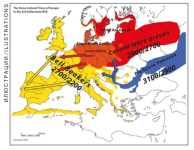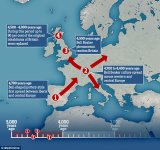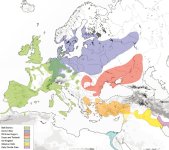joeflood said:
Look Athiudisk, seriously you are not on a winner here. First are we sure that single L23* was tested fully? As far as I know it was poor DNA so they couldn't get the subclade. It's an awful lot to hang off a sample of one.
It's not just the one sample, but the presence of Yamna-derived ancestry across Europe as well. Taking the two together, I don't see how one can conclude the theory I'm supporting is at all impossible.
Even as late as 0AD Germany was 70% forest, back then it was all forest except the river valleys. Now you are proposing that one of these very rare L23* plains dwellers slipped into the forest, presumably running away from that R1a hordes, and leaving no trail behind, made it across a thousand miles of dangerous uncharted forest. having a L51, a L151 and P312 mutation along the way, then with no support. set up a vast and mighty dynasty on the Atlantic. It goes beyond improbable.
More like L23 split into L51 and Z2103 branches in eastern Europe, with L51 (and then L11, etc.) moving westward, and its descendants expanding across the rest of Europe. They brought their support with them as they came; we're not talking about a single man with his sons alone, but a larger-scale migration. I see nothing improbable about it.
What you have to keep in mind is that Mr Western R1b on the Atlantic, Mr Eastern R1a in the Baltic, and Mr I1 too wherever he was, each descended from a single man who lived around 3000 BC, if yfull,com timings are right. So we need to get those three men into place at the right time with adequate support so that their lines can dominate in the Early Bronze population explosion.
I believe that R1 came with/brought the Bronze Age explosion, in many cases; I1 was already in place when R1 arrived. The two combined (most notably into Germanic cultures) as R1 entered from the east.
It's far more likely (and this needs quite a bit of explanation too) that R1b from the Mediterranean sailed around to Spain, set up a decent sort of Beaker colony, then expanded massively from there. They started chopping forest from the West and before too long met up with R1a chopping forest from the East. They both had steppe-type Bronze culture and probably got on alright so they formed the very disparate Corded Ware society - R1a in the East, R1b and I1 in the West.
I don't know about more likely, but it's certainly an interesting possibility. What evidence suggests to you that R1b spread throughout Europe from Iberia?
At this point, as you are committed to one thing, we may have to agree to disagree. However you going to hear a lot more about the early Bronze Atlantic Culture, I am selling it quite hard now that I have settled on a possible solution. The incidental evidence is actually fairly reasonable, and once people stop dismissing it as myth and start looking for evidence around the Atlantic using our new dating tools - instead of wasting their time on a dead end in the Ukraine - we will get a pretty solid theory I think. Certainly a lot more exciting than sheepherders.
We'll see. At present, I see no evidence to suggest R1b skipped from eastern Europe or the Levant to Iberia and then expanded from there.
No they don't, unless you mean around the Mediterranean
They do, though. We have L23 around the Black and Caspian Seas, both ancient and modern, then L51 across Europe to the west. L23 is older than L51.
From the genetics point of view there is one thing that really makes the Yamnaya a very unlikely starter for Western R1b. L51 precedes the Yamnaya, which dates 3600-2300 BC. If yfull's timings are correct L51 formed about 4100BC, 500 years earlier, and has TMRCA of 3800 BC pre Yamnaya. If they were ancestors of Western R1b, L51 would have to be ancestors of at least some of them. Where are the L51s?
In remains we haven't sampled yet. L51's father and brother are both at the eastern end of Yamnaya; why is it impossible that L51 is somewhere in that horizon as well? If L51 came from western Europe, how did it's father and brother end up north of the Caspian? I don't see a simple explanation; it's
possible that, as you believe, there was a migration through the Mediterranean, but I see no reason to propose it, currently.
You really need to look at the other branch under L51, Z1111/PF7589, which also is supposed to be older than Yamnaya. I see eight on FTDNA. One in Spain, one in Italy, three in Britain, one in Greece, two unknown. Looking awfully like Atlantic-Mediterranean seagoing culture and nothing at all like Yamnaya?
I think you mean Z2111. In any event, all that demonstrates is that L51 and its descendants made it to Europe. If Z2111 means that L51 was born in western Europe, why doesn't Z2103 mean that L23 was born on the steppe?
A given clade being older than a culture doesn't really mean anything. Some people will keep the same terminal SNP without further mutations. My haplogroup is older than European settlement in the New World, but I'm still an American. Hells, there are still Y-DNA A people running around, and A predates anything we'd call civilization.
We are looking for a chain of descendants and sidelines. These do NOT occur along the path from Ukraine to the Atlantic.
Other things have occurred in the last few thousand years that might make such a direct trail hard to follow in the manner you suggest. As a relevant example, the mass migration of Slavs across eastern Europe.
They DO occur from Turkey around the Mediterranean, Greece, Italy, around into Spain and thence to Britain. Along which path would you look for your ancestors?
Looking at my own ancestors, I see U106 entering Britain (where my terminal SNP is largely found) in the last two-thousand years. The oldest U106 we have is from Corded Ware in what's now Sweden. Corded Ware drew most of its ancestry from Yamnaya, where U106's ancestor L23 has been found.
I don't see any reason as of yet to believe my ancestors in Corded Ware got there from Yamnaya by way of Spain, instead of simply moving west. If this changes, as you suspect it will, I'll obviously reconsider.





